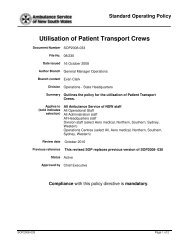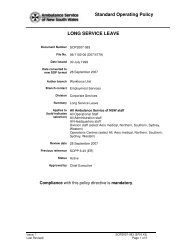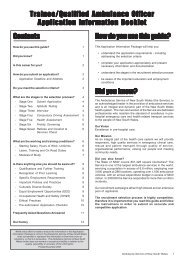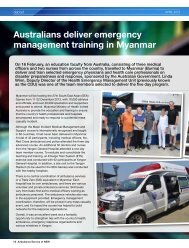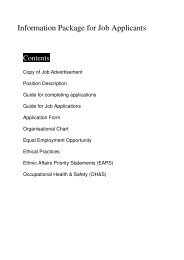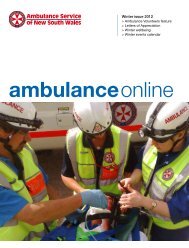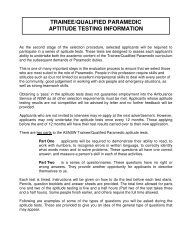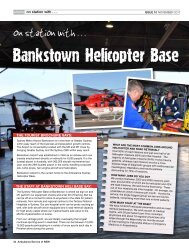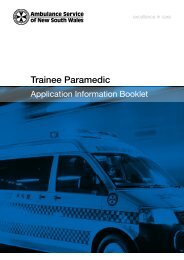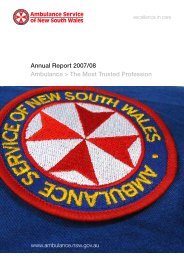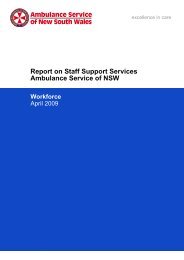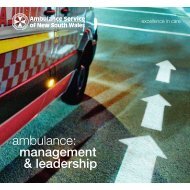atsb final report released 16 may 2013 - Ambulance Service of NSW
atsb final report released 16 may 2013 - Ambulance Service of NSW
atsb final report released 16 may 2013 - Ambulance Service of NSW
Create successful ePaper yourself
Turn your PDF publications into a flip-book with our unique Google optimized e-Paper software.
from the rock ledge after connecting to the winch hook, contact with the unevenground below was unavoidable.The processes <strong>of</strong> climbing the helicopter and winching in the winch cable, eithersingularly or in combination, acted to tension the winch cable. In addition, thismanoeuvre was carried out in low light conditions, preventing the ACM from beingable to see all <strong>of</strong> the winch cable clearly. This adversely affected his ability toaccurately assess the effect <strong>of</strong> commanding the upwards movement <strong>of</strong> thehelicopter, while winching in the cable slack. The result was that the injuredcanyoner and duty paramedic were unintentionally pulled from the ledge. This wasconsistent with the absence in the recorded data <strong>of</strong> all but the ‘winching in theslack’ standard winching command by the ACM, and the injured canyoner’sobservation that the helicopter climbed out <strong>of</strong> his view shortly before he and theduty paramedic were pulled from the rock ledge.Importantly, the flight crew considered that the winching operation was proceedingsafely up until the fall occurred. In this context, the use <strong>of</strong> a ‘pause point’ riskassessment at an agreed time during the winch, such as prior to hook-up, wouldhave provided an opportunity to identify and manage the risk associated with theACM being unable to clearly see all <strong>of</strong> the winch cable.Rope stabilising systemThe Australian Transport Safety Bureau (ATSB) considered a number <strong>of</strong> reasonswhy there was no evidence <strong>of</strong> the planned stabilising system, including theassociated anchors, on the rock ledge. The possibility that the site had beentampered with prior to examination was considered; however, given its relativelyremote location and difficult access, that was considered unlikely.The observation by National Parks and Wildlife field <strong>of</strong>ficers <strong>of</strong> the red safety ropecoiled up on a bag adjacent to the abseiling rope indicated that it had not been usedin the attempted retrieval. In addition, the as-found position <strong>of</strong> the red rope meantthat the duty paramedic would have been unable to reach it from the hook-upposition on the ledge. This suggested that the paramedic did not intend to use thered rope once connected to the winch hook. Based on these observations, it isprobable that, in the low light conditions, the ACM’s perception that the paramediceased himself and the injured canyoner away from the rock ledge using a red ropewas incorrect. His assessment that the first movement <strong>of</strong> the duty paramedic andinjured canyoner appeared to be controlled was probably due to them beinginadvertently drawn from their position at winch hook-up to the edge <strong>of</strong> the rockledge by the increasing tension on the winch cable. The ACM’s perception <strong>of</strong> afailure or loss <strong>of</strong> control <strong>of</strong> the stabilising rope by the duty paramedic correspondedto the fall from the ledge.Excluding the possibility that the red rope was used, only the yellow tag line wasavailable for use as a stabilising rope. Discussion with a number <strong>of</strong> Special CasualtyAccess Team (SCAT) personnel highlighted that the duty paramedic <strong>may</strong> have usedan anchor system that permitted him to retrieve the stabilising rope after being liftedby the winch, leaving no evidence <strong>of</strong> either the anchor system or rope. However,given that the duty paramedic’s plan was to discard the stabilising rope once theparamedic and injured canyoner where directly underneath the helicopter’s winch,the establishment <strong>of</strong> a more complex self-retrieval system was considered unlikely.- 38 -



